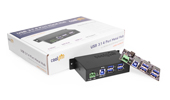Running a business fleet of vehicles is about more than just providing service or transportation. Each vehicle is an extension of the business and a conveyance for employees. The vehicle is at once responsible for employee safety and an asset that represents company responsibility. So it comes as no surprise that an increasing number of companies are upfitting their fleets not just with cool tech for convenience but also with emergency and liability safety technology.
What do we mean by that? Today, we’re talking about technology designed to both protect your employees from harm and protect the company and drivers from false liability claims if the vehicle is involved in an accident. Outside your company headquarters is a big world of possibilities, and not all of them are awesome. Upfitting your fleet with these five technologies can significantly increase driver safety and company safety should worst-case-scenarios occur.
1) Streaming Dash Cams, Front and Back
Dash cams have been around for over a decade but have recently risen to even greater usefulness. Now you have the ability to record, archive, and even internet-stream the footage collected from dash cams at both the front and rear of every company fleet vehicle.
This records what is going on around the vehicle at all times, acting simultaneously as a trip record and a security camera setup at the same time. If one of your drivers is involved in an accident, you can review the footage (potentially live-streamed to HQ) immediately to learn exactly what happened.
This can tell you if the fleet vehicle or the other involved drivers were at fault, what happened before and after the accident, and even collect evidence for police and insurance companies like the license plate of a hit-and-run vehicle. Not to mention, you can use any dash cam footage to create training videos for new drivers.
2) Safe Driving Guidance Cameras
Guidance cameras are a feature usually only seen on very high-end vehicles but just because your fleet didn’t come with them installed doesn’t mean you can’t have them. By installing very small cameras at the corners of each bumper, you can make it possible for your drivers to always see a few feet out from their vehicle. They can better see curbs, approaching vehicles, and other details through a simulated top-view, giving a safe-driving and safe-parking perspective that few non-luxury drivers get to experience.
This can act to protect both the vehicle and your drivers as an extra point of perspective and visual safety.
3) Onboard Dispatch Direct Assistance
We love the idea of car insurance and roadside assistance companies that can ‘phone’ directly into the car with hands-free communication if a problem is detected. But you don’t have to have On-Star or similar services to provide the same kind of cool integrated support for your fleets. With today’s wireless technology, you can hook Dispatch directly into built-in car speakers any time something alarming is detected through your GPS tracking, OBD sensor, or just if drivers hit an available button or speak a specific “wake word” to call dispatch.
This way, you don’t have to rely on phones that may or may not be charged to immediately open a support call between your fleet vehicles and dispatch. This can be particularly useful during difficult driving situations and in the event of an emergency.
4) Authorized Employee Driver Detection
If you have ever worried that non-authorized employees or even non-employees will get behind the wheel, there’s technology for that, too. There are, actually, many different ways to upfit your fleet vehicles to detect if the driver is an authorized driving employee. You might use RFID detection to sense an employee badge or wristband. You might use biometric data like fingerprints, eye scans, or voice recognition. Or an automated system might ask for a specific passcode or even a quiz question that only an authorized driver would know the answer to.
We advise that you do not disable a vehicle without an authorized driver, in case the vehicle needs to be moved by a non-driver in an emergency. But a non-authorized driver should absolutely trigger a call-through from dispatch and live GPS tracking.
5) Self-Generating Route Records
Finally, with very little upfitting at all, you can set up your vehicles to create automatic records of the routes they have taken. Using GPS geofencing, and/or navigation systems you can create simple or detailed logs of company vehicle whereabouts. These logs will not be employee-editable because they will be based only on the physical locations of the vehicle at set times or when destinations were reached. In case the location of each vehicle ever comes into question, these records will be incredibly useful to show both where vehicles were point-to-point and the routes they took along with exact times.
You can use this data to analyze route efficiency and on-time customer care. And, should it ever come up, law enforcement can make use of this data to confirm that your vehicles were on route and occupied during any times in question.
—
Upfitting your business fleet with clever technological upgrades isn’t just for efficiency and coolness factor, it can also keep your teams safe from physical and legal dangers as well. Working on a new design for upfitting your fleet? Contact us today to speak to one of our specialists about vehicle upfitting and where the future is taking business technology!



















